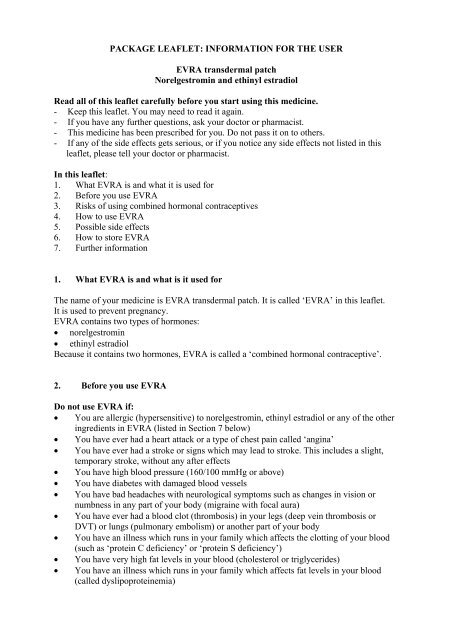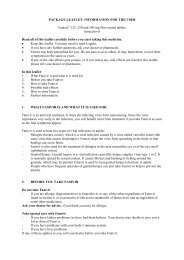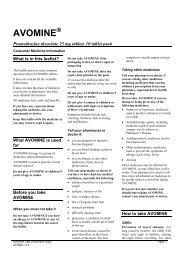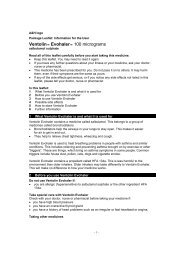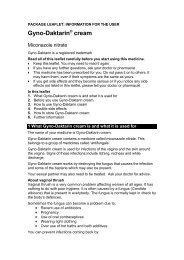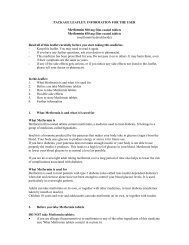package leaflet: information for the user - HealthExpress.co.uk
package leaflet: information for the user - HealthExpress.co.uk
package leaflet: information for the user - HealthExpress.co.uk
Create successful ePaper yourself
Turn your PDF publications into a flip-book with our unique Google optimized e-Paper software.
PACKAGE LEAFLET: INFORMATION FOR THE USER<br />
EVRA transdermal patch<br />
Norelgestromin and ethinyl estradiol<br />
Read all of this <strong>leaflet</strong> carefully be<strong>for</strong>e you start using this medicine.<br />
- Keep this <strong>leaflet</strong>. You may need to read it again.<br />
- If you have any fur<strong>the</strong>r questions, ask your doctor or pharmacist.<br />
- This medicine has been prescribed <strong>for</strong> you. Do not pass it on to o<strong>the</strong>rs.<br />
- If any of <strong>the</strong> side effects gets serious, or if you notice any side effects not listed in this<br />
<strong>leaflet</strong>, please tell your doctor or pharmacist.<br />
In this <strong>leaflet</strong>:<br />
1. What EVRA is and what it is used <strong>for</strong><br />
2. Be<strong>for</strong>e you use EVRA<br />
3. Risks of using <strong>co</strong>mbined hormonal <strong>co</strong>ntraceptives<br />
4. How to use EVRA<br />
5. Possible side effects<br />
6. How to store EVRA<br />
7. Fur<strong>the</strong>r <strong>in<strong>for</strong>mation</strong><br />
1. What EVRA is and what is it used <strong>for</strong><br />
The name of your medicine is EVRA transdermal patch. It is called ‘EVRA’ in this <strong>leaflet</strong>.<br />
It is used to prevent pregnancy.<br />
EVRA <strong>co</strong>ntains two types of hormones:<br />
• norelgestromin<br />
• ethinyl estradiol<br />
Because it <strong>co</strong>ntains two hormones, EVRA is called a ‘<strong>co</strong>mbined hormonal <strong>co</strong>ntraceptive’.<br />
2. Be<strong>for</strong>e you use EVRA<br />
Do not use EVRA if:<br />
• You are allergic (hypersensitive) to norelgestromin, ethinyl estradiol or any of <strong>the</strong> o<strong>the</strong>r<br />
ingredients in EVRA (listed in Section 7 below)<br />
• You have ever had a heart attack or a type of chest pain called ‘angina’<br />
• You have ever had a stroke or signs which may lead to stroke. This includes a slight,<br />
temporary stroke, without any after effects<br />
• You have high blood pressure (160/100 mmHg or above)<br />
• You have diabetes with damaged blood vessels<br />
• You have bad headaches with neurological symptoms such as changes in vision or<br />
numbness in any part of your body (migraine with focal aura)<br />
• You have ever had a blood clot (thrombosis) in your legs (deep vein thrombosis or<br />
DVT) or lungs (pulmonary embolism) or ano<strong>the</strong>r part of your body<br />
• You have an illness which runs in your family which affects <strong>the</strong> clotting of your blood<br />
(such as ‘protein C deficiency’ or ‘protein S deficiency’)<br />
• You have very high fat levels in your blood (cholesterol or triglycerides)<br />
• You have an illness which runs in your family which affects fat levels in your blood<br />
(called dyslipoproteinemia)
• You have ever had liver tumours or any problem with your liver<br />
• You have ever been told you might have breast cancer or cancer of <strong>the</strong> womb, cervix or<br />
vagina<br />
• You have unexplained vaginal bleeding.<br />
Do not use EVRA if any of <strong>the</strong> above apply to you. If you are not sure, talk to your doctor or<br />
pharmacist be<strong>for</strong>e using EVRA.<br />
Take special care with EVRA<br />
Medical check-ups<br />
Be<strong>for</strong>e using EVRA, you will need to see your doctor <strong>for</strong> a medical check-up.<br />
Check with your doctor or pharmacist be<strong>for</strong>e using EVRA if you have any of <strong>the</strong> following or<br />
<strong>the</strong>y happen or get worse while using EVRA:<br />
- You weigh 90 kg (which is 14 stone 2 lb) or more<br />
- You, or any of your family, have high fat levels in <strong>the</strong> blood (triglycerides or cholesterol)<br />
- You have high blood pressure or your blood pressure gets higher<br />
- You have a blood problem called porphyria<br />
- You have an immune system problem called ‘SLE’ (systemic lupus ery<strong>the</strong>matosus)<br />
- You have a blood problem which causes kidney damage called ‘HUS’ (haemolytic<br />
uremic syndrome)<br />
- You have a hearing loss<br />
- You have epilepsy or any o<strong>the</strong>r problem that can cause fits (<strong>co</strong>nvulsions)<br />
- You have a problem of <strong>the</strong> nervous system involving sudden movements of <strong>the</strong> body<br />
called ‘Sydenham’s chorea’<br />
- You have diabetes<br />
- You have depression<br />
- You have gallstones<br />
- You have liver problems including yellowing of <strong>the</strong> skin and whites of <strong>the</strong> eye (jaundice)<br />
- You have an inflammatory illness of your gut (Crohn’s disease or ulcerative <strong>co</strong>litis)<br />
- You had a skin rash with blisters during pregnancy (called ‘herpes gestationis’)<br />
- You have ‘pregnancy spots’. These are yellowish-brown patches or spots, especially on<br />
your face (called ‘chloasma’)<br />
- You think you might be pregnant.<br />
If you are not sure if any of <strong>the</strong> above apply to you, talk to your doctor or pharmacist be<strong>for</strong>e<br />
using EVRA.<br />
Taking o<strong>the</strong>r medicines:<br />
Please tell your doctor or pharmacist if you are taking or have recently taken any o<strong>the</strong>r<br />
medicines. This includes medicines obtained without a prescription, including herbal<br />
medicines.<br />
Certain medicines and herbal remedies may stop EVRA from working properly. If this<br />
happens you <strong>co</strong>uld get pregnant.<br />
Tell your doctor if you are taking:<br />
• Medicines <strong>for</strong> HIV infection (such as ritonavir, nevirapine)<br />
• Medicines <strong>for</strong> infection (such as rifampicin and griseofulvin)<br />
• Medicines <strong>for</strong> epilepsy (such as topiramate, barbiturates, phenytoin sodium,<br />
carbamazepine, primidone, oxcarbamazepine and felbamate)
• Medicine <strong>for</strong> high blood pressure in <strong>the</strong> blood vessels in <strong>the</strong> lungs (bosentan)<br />
• St. John’s Wort - an herbal remedy used <strong>for</strong> depression.<br />
If you take any of <strong>the</strong>se medicines, you may need to use ano<strong>the</strong>r method of birth <strong>co</strong>ntrol (such<br />
as a <strong>co</strong>ndom, diaphragm or foam). The interfering effect of some of <strong>the</strong>se medicines can last<br />
<strong>for</strong> up to 28 days after you have stopped taking <strong>the</strong>m.<br />
Blood levels of estrogen from EVRA may be increased if you take certain medicines or drink<br />
grapefruit juice.<br />
EVRA may make some o<strong>the</strong>r medicines less effective, such as:<br />
• medicines <strong>co</strong>ntaining ciclosporin<br />
• <strong>the</strong> anti-epileptic lamotrigine<br />
(This can increase <strong>the</strong> risk of fits (seizures)).<br />
Ask your doctor or pharmacist <strong>for</strong> advice be<strong>for</strong>e taking any medicine.<br />
Using EVRA with food and drink<br />
It is not expected that food or drink will affect <strong>the</strong> way EVRA works.<br />
Pregnancy and breast-feeding<br />
• Do not use EVRA if you are pregnant or think you may be pregnant<br />
• Do not use EVRA if you are breast-feeding or planning to breast-feed.<br />
Ask your doctor or pharmacist <strong>for</strong> advice be<strong>for</strong>e taking any medicine during pregnancy or<br />
while breast-feeding.<br />
Driving and using machines<br />
You can drive or operate machinery while using EVRA.<br />
Sexually transmitted disease<br />
EVRA will not protect you against HIV infection (AIDS) or any o<strong>the</strong>r sexually transmitted<br />
disease. These include chlamydia, genital herpes, genital warts, gonorrhoea, hepatitis B,<br />
syphilis. Always use <strong>co</strong>ndoms to protect yourself from <strong>the</strong>se diseases.<br />
Medical tests<br />
• Tell your doctor or <strong>the</strong> person taking <strong>the</strong> sample, if you are having a blood or urine test.<br />
This is because EVRA may affect some results of <strong>the</strong> tests.<br />
3. Risks of using <strong>co</strong>mbined hormonal <strong>co</strong>ntraceptives<br />
The following <strong>in<strong>for</strong>mation</strong> is based on <strong>in<strong>for</strong>mation</strong> about <strong>co</strong>mbined birth <strong>co</strong>ntrol pills. As <strong>the</strong><br />
EVRA transdermal patch <strong>co</strong>ntains similar hormones to those used in <strong>co</strong>mbined birth <strong>co</strong>ntrol<br />
pills, it is likely to have <strong>the</strong> same risks. All <strong>co</strong>mbined birth <strong>co</strong>ntrol pills have risks, which may<br />
lead to disability or death.<br />
It has not been shown that a transdermal patch like EVRA is safer than a <strong>co</strong>mbined birth<br />
<strong>co</strong>ntrol pill taken by mouth.<br />
Combined hormonal <strong>co</strong>ntraceptives and blood clots (thrombosis)<br />
Using <strong>co</strong>mbined hormonal <strong>co</strong>ntraceptives, including EVRA, increases <strong>the</strong> chances of getting a<br />
thrombosis (blood clots). It is possible that <strong>the</strong> risk of blood clots in <strong>the</strong> legs and/or lungs with<br />
EVRA is more than <strong>the</strong> risk with <strong>co</strong>mbined birth <strong>co</strong>ntrol pills. This risk of developing blood
clots is not affected by how long you use <strong>the</strong> medicine. The risk returns to normal, a few<br />
months after you stop using <strong>the</strong> medicine.<br />
Blood clots can cause a blockage in a vein or artery and this may make you permanently<br />
disabled or even cause death.<br />
• Blood clots can <strong>for</strong>m in a vein in your leg (deep vein thrombosis or DVT) and travel to<br />
<strong>the</strong> lungs. This can cause chest pain and make you breathless or <strong>co</strong>llapse. This is called<br />
a ‘pulmonary embolism’ or PE<br />
• Very rarely, blood clots can <strong>for</strong>m in <strong>the</strong> blood vessels of <strong>the</strong> heart (causing a heart<br />
attack) or <strong>the</strong> brain (causing a stroke)<br />
• In extremely rare cases, blood clots can happen in o<strong>the</strong>r places such as <strong>the</strong> liver, gut,<br />
kidney or eye. Blood clots in <strong>the</strong> eye may cause loss of eyesight or double vision.<br />
Tell your doctor immediately if you notice any possible signs of a blood clot, such as:<br />
• Pain or swelling in ei<strong>the</strong>r leg<br />
• Pain in <strong>the</strong> chest, which may spread to <strong>the</strong> arm<br />
• Sudden shortness of breath or sudden <strong>co</strong>ughing<br />
• Unusual, severe or long-lasting headache<br />
• Vision problems<br />
• Difficulty speaking<br />
• Feeling dizzy or fainting spells<br />
• Feeling weak or numb on one side or one part of <strong>the</strong> body<br />
• Difficulty walking or holding things<br />
• Sudden stomach pain<br />
If you think you might have any of <strong>the</strong>se, talk to your doctor immediately.<br />
Your chance of getting a blood clot increases:<br />
• As you get older<br />
• If blood clots in blood vessels (veins or arteries) runs in <strong>the</strong> family<br />
• If you smoke, especially if you are over 35 years of age<br />
• If you stay in bed <strong>for</strong> many days<br />
• If you are very overweight<br />
• If you have just had a baby, miscarriage or abortion<br />
• If you have had a serious injury, particularly of <strong>the</strong> leg or hip<br />
• If you have had or are going to have a major operation or need to have bed rest <strong>for</strong> a<br />
long time. Normally you should not use EVRA <strong>for</strong> two weeks be<strong>for</strong>e or two weeks after<br />
surgery<br />
• If you have ever had blood clots be<strong>for</strong>e<br />
• If you have problems with your blood fats (cholesterol or triglycerides)<br />
• If you have high blood pressure<br />
• If you have heart problems (problems with heart valves, abnormal heart rhythm).<br />
Combined hormonal <strong>co</strong>ntraceptives and cancer<br />
Breast cancer<br />
Breast cancer has been found more often in women who take <strong>co</strong>mbined hormonal<br />
<strong>co</strong>ntraceptives. However, it is possible that <strong>the</strong> <strong>co</strong>mbined hormonal <strong>co</strong>ntraceptive is not <strong>the</strong><br />
cause of more women having breast cancer. It may be that women taking <strong>the</strong> <strong>co</strong>mbined<br />
hormonal <strong>co</strong>ntraceptive are examined more often. This might mean that <strong>the</strong>re is a better<br />
chance of <strong>the</strong> breast cancer being noticed. The increased risk gradually goes down after<br />
stopping <strong>the</strong> <strong>co</strong>mbined hormonal <strong>co</strong>ntraceptive. After 10 years, <strong>the</strong> risk is <strong>the</strong> same as <strong>for</strong><br />
people who have never used <strong>the</strong> <strong>co</strong>mbined hormonal <strong>co</strong>ntraceptive.
Cervical cancer<br />
Cervical cancer also has been found more often in women taking <strong>co</strong>mbined hormonal<br />
<strong>co</strong>ntraceptives. However, this may be due to o<strong>the</strong>r causes. These include more sexual partners<br />
and sexually transmitted disease.<br />
Liver cancer<br />
In rare cases, liver tumours which are not cancer have been found in women taking <strong>co</strong>mbined<br />
hormonal <strong>co</strong>ntraceptives. Even more rarely, liver tumours which are cancer have been found.<br />
This can cause bleeding inside <strong>the</strong> body with very bad pain in <strong>the</strong> stomach area. If this<br />
happens to you, talk to your doctor immediately.<br />
4. How to use EVRA<br />
Always use EVRA exactly as described in this <strong>leaflet</strong>.<br />
• If you do not, you may increase your risk of getting pregnant<br />
• Check with your doctor or pharmacist if you are not sure<br />
• Always keep non-hormonal <strong>co</strong>ntraceptives (such as <strong>co</strong>ndoms, foam or sponge) as a<br />
back-up in case you make a mistake when using <strong>the</strong> patch.<br />
Talk to your doctor about using EVRA after having a baby or after an abortion or miscarriage.<br />
How many patches to use<br />
• Weeks 1, 2 & 3: Put on one patch and leave it on <strong>for</strong> exactly seven days<br />
• Week 4: Do not put on a patch this week.<br />
Important <strong>in<strong>for</strong>mation</strong> to follow when using <strong>the</strong> patch<br />
• Change EVRA on <strong>the</strong> same day of each week. This is because it is designed to work<br />
over 7 days<br />
• Never go without wearing a patch <strong>for</strong> more than 7 days in a row<br />
• Only wear one patch at a time<br />
• Do not put <strong>the</strong> patch on skin that is red, irritated or cut<br />
• To work properly <strong>the</strong> patch must stick firmly to your skin<br />
- Press <strong>the</strong> patch down firmly until <strong>the</strong> edges stick well<br />
- Do not use creams, oils, lotions, powder or makeup on <strong>the</strong> skin where you are placing a<br />
patch or near a patch you are wearing. This may make <strong>the</strong> patch <strong>co</strong>me loose<br />
• Do not put a new patch on <strong>the</strong> same area of skin as <strong>the</strong> old patch. If you do you are<br />
more likely to cause irritation<br />
• Check each day to make sure <strong>the</strong> patch has not fallen off<br />
• Keep using <strong>the</strong> patches even if you do not have sex very often.
How to use <strong>the</strong> patch:<br />
If this is <strong>the</strong> first time you are using EVRA, wait until <strong>the</strong> day you<br />
get your menstrual period.<br />
• Apply your first patch during <strong>the</strong> first 24 hours of your<br />
period<br />
• If <strong>the</strong> patch is put on after <strong>the</strong> first day of your period, use a<br />
non-hormonal <strong>co</strong>ntraceptive until Day 8, when you change<br />
your patch<br />
• The day you apply your first patch will be Day 1. Your<br />
“Patch Change Day” will be on this day of <strong>the</strong> week<br />
every week.<br />
Choose a place on your body to put <strong>the</strong> patch.<br />
• Always put your patch on clean, dry, hairless skin<br />
• Put it on <strong>the</strong> buttock, abdomen, upper outer arm or upper back -<br />
places where it won’t be rubbed by tight clothing<br />
• Never put <strong>the</strong> patch on your breasts.<br />
Using your fingers, open <strong>the</strong> foil sachet<br />
• Open it by tearing it along <strong>the</strong> edge (do not use scissors)<br />
• Firmly grasp a <strong>co</strong>rner of <strong>the</strong> patch and gently take it from <strong>the</strong><br />
foil sachet<br />
• There is a clear protective <strong>co</strong>vering on <strong>the</strong> patch<br />
• Sometimes patches can stick to <strong>the</strong> inside of <strong>the</strong> sachet – be<br />
careful not to accidentally remove <strong>the</strong> clear <strong>co</strong>vering as you<br />
remove <strong>the</strong> patch<br />
• Then peel away half of <strong>the</strong> clear protective <strong>co</strong>vering (see<br />
picture). Try not to touch <strong>the</strong> sticky surface.<br />
Put <strong>the</strong> patch on your skin<br />
• Then take off <strong>the</strong> o<strong>the</strong>r half of <strong>the</strong> <strong>co</strong>vering<br />
• Press down firmly on <strong>the</strong> patch with <strong>the</strong> palm of your hand <strong>for</strong><br />
10 se<strong>co</strong>nds<br />
• Make sure that <strong>the</strong> edges stick well.<br />
Wear <strong>the</strong> patch <strong>for</strong> 7 days (one week)<br />
• On <strong>the</strong> first “Patch Change Day”, Day 8, take off <strong>the</strong> used<br />
patch<br />
• Put on a new patch immediately.
• On Day 15 (Week 3), take off <strong>the</strong> used patch<br />
• Put on ano<strong>the</strong>r new one.<br />
This makes a total of three weeks with <strong>the</strong> patches.<br />
To help stop irritation, do not put <strong>the</strong> new patch on exactly <strong>the</strong><br />
same area of your skin as your last patch.<br />
Do not wear a patch on Week 4 (Day 22 through Day 28).<br />
• You should have your period during this time<br />
• During this week you are protected from getting pregnant only<br />
if you start your next patch on time.<br />
For your next four week cycle<br />
• Put on a new patch on your normal “Patch Change Day”, <strong>the</strong><br />
day after Day 28<br />
• Do this no matter when your period begins or ends.<br />
If you want to change your “Patch Change Day” to a different day of <strong>the</strong> week talk to your<br />
doctor.<br />
Everyday activities while using <strong>the</strong> patches<br />
• Normal activities such as having a bath or shower, using a sauna and exercising should<br />
not affect how well <strong>the</strong> patch works<br />
• The patch is designed to stay in place during <strong>the</strong>se types of activities<br />
• However, you should check that <strong>the</strong> patch has not fallen off after doing <strong>the</strong>se activities.<br />
If you need to place <strong>the</strong> patch on a new area on your body on a day o<strong>the</strong>r than your<br />
“Patch Change Day”<br />
If <strong>the</strong> patch causes irritation or you be<strong>co</strong>me un<strong>co</strong>m<strong>for</strong>table wearing it:<br />
• You can take it off and replace it with a new patch in a different place on your body<br />
until your next “Patch Change Day”<br />
• You may only use one patch at a time.<br />
If you have trouble remembering to change your patch<br />
• Talk to your doctor or ano<strong>the</strong>r healthcare professional at <strong>the</strong> clinic. He/she may be able<br />
to make patch changing easier <strong>for</strong> you. He/she may also talk about whe<strong>the</strong>r you need to<br />
use ano<strong>the</strong>r method of <strong>co</strong>ntraception.<br />
If your patch be<strong>co</strong>mes loose, lifts at <strong>the</strong> edges or falls off<br />
For less than one day (up to 24 hours):<br />
• Try to put it on again or put on a new patch immediately<br />
• Back-up <strong>co</strong>ntraception is not needed<br />
• Your “Patch Change Day” should remain <strong>the</strong> same<br />
• Do not try to put a patch back on if:<br />
- it is no longer sticky<br />
- it has be<strong>co</strong>me stuck to itself or ano<strong>the</strong>r surface<br />
- it has o<strong>the</strong>r material stuck to it<br />
- it is <strong>the</strong> se<strong>co</strong>nd time it has be<strong>co</strong>me loose or has fallen off
• Do not use tapes or wrapping to keep <strong>the</strong> patch in place<br />
• If you cannot get a patch back on, put on a new patch immediately.<br />
For more than one day (24 hours or more) or if you are not sure <strong>for</strong> how long:<br />
• Start a new four week cycle immediately by putting on a new patch<br />
• You now have a new Day 1 and a new “Patch Change Day”<br />
• You must use non-hormonal <strong>co</strong>ntraception as back up <strong>for</strong> <strong>the</strong> first week of your new<br />
cycle.<br />
You may get pregnant if you do not follow <strong>the</strong>se instructions.<br />
If you <strong>for</strong>get to change your patch<br />
At <strong>the</strong> start of any patch cycle (Week 1 (Day 1)):<br />
If you <strong>for</strong>get to put on your patch, you may be at particularly high risk of be<strong>co</strong>ming<br />
pregnant.<br />
• You must use non-hormonal <strong>co</strong>ntraception as back up <strong>for</strong> one week<br />
• Put on <strong>the</strong> first patch of your new cycle as soon as you remember<br />
• You now have a new “Patch Change Day” and new Day 1.<br />
In <strong>the</strong> middle of your patch cycle (Week 2 or 3):<br />
If you <strong>for</strong>get to change your patch <strong>for</strong> one or two days (up to 48 hours):<br />
• You must put on a new patch as soon as you remember<br />
• Put on your next patch on your normal “Patch Change Day”.<br />
No back up <strong>co</strong>ntraception is needed.<br />
For more than 2 days (48 hours or more):<br />
• If you <strong>for</strong>get to change your patch <strong>for</strong> more than 2 days, you may be<strong>co</strong>me pregnant<br />
• You must start a new four week cycle as soon as you remember by putting on a new<br />
patch<br />
• You now have a different “Patch Change Day” and a new Day 1<br />
• You must use back-up <strong>co</strong>ntraception <strong>for</strong> <strong>the</strong> first week of your new cycle.<br />
At <strong>the</strong> end of your patch cycle (Week 4):<br />
If you <strong>for</strong>get to take off your patch:<br />
• Take it off as soon as you remember<br />
• Start your next cycle on your normal “Patch Change Day”, <strong>the</strong> day after Day 28.<br />
No back-up <strong>co</strong>ntraception is needed.<br />
If you switch from <strong>the</strong> oral <strong>co</strong>ntraceptive pill to EVRA<br />
If you are switching from an oral <strong>co</strong>ntraceptive pill to EVRA:<br />
• Wait until you get your menstrual period<br />
• Put on your first patch during <strong>the</strong> first 24 hours of your period.<br />
If <strong>the</strong> patch is applied after Day 1 of your period, you should:<br />
• Use a non-hormonal <strong>co</strong>ntraceptive until Day 8 when you change your patch.<br />
If you do not get your period within 5 days of taking <strong>the</strong> last <strong>co</strong>ntraceptive pill, check with<br />
your doctor be<strong>for</strong>e starting EVRA.<br />
If you switch from <strong>the</strong> mini-pill to EVRA<br />
• You may start EVRA any day after stopping <strong>the</strong> mini-pill<br />
• The first day after stopping <strong>the</strong> mini-pill, put on a patch<br />
• Use a non-hormonal <strong>co</strong>ntraceptive until Day 8, when you change your patch.
If you have absent or irregular bleeding with EVRA<br />
EVRA may cause unexpected vaginal bleeding or spotting during <strong>the</strong> weeks when you are<br />
wearing <strong>the</strong> patch<br />
• This usually stops after <strong>the</strong> first few cycles<br />
• Mistakes in using your patches can also cause spotting and light bleeding<br />
• Continue using EVRA and if <strong>the</strong> bleeding lasts more than <strong>the</strong> first three cycles, talk to<br />
your doctor or pharmacist.<br />
If you do not get your period during <strong>the</strong> EVRA patch-free week (Week 4), you should still use<br />
a new patch on your usual “Patch Change Day”.<br />
• If you have been using EVRA <strong>co</strong>rrectly and you do not have a period, this does not<br />
necessarily mean that you are pregnant<br />
• However, if you miss two periods in a row, talk to your doctor or pharmacist as you<br />
may be pregnant.<br />
If you use more than one EVRA patch at any one time<br />
Take <strong>the</strong> patches off and talk to a doctor immediately.<br />
Using too many patches may cause you to have <strong>the</strong> following:<br />
• Feeling sick (nausea) and being sick (vomiting)<br />
• Bleeding from <strong>the</strong> vagina.<br />
If you stop using EVRA<br />
You may get irregular, little or no bleeding. This usually happens in <strong>the</strong> first 3 months and<br />
especially if your periods were not regular be<strong>for</strong>e you started using EVRA.<br />
If you have any fur<strong>the</strong>r questions on <strong>the</strong> use of this product, ask your doctor or pharmacist.<br />
5. Possible side effects<br />
Like all medicines, EVRA can cause side effects although not everybody gets <strong>the</strong>m.<br />
Tell your doctor if you notice any unwanted effects. If you think that you have a serious side<br />
effect when using EVRA, take off <strong>the</strong> patch and speak to your doctor or pharmacist<br />
immediately. In <strong>the</strong> meantime, you should use ano<strong>the</strong>r method of <strong>co</strong>ntraception.<br />
Serious side effects associated with <strong>co</strong>mbined hormonal <strong>co</strong>ntraceptives are described in<br />
Section 3 above (“Risks of using <strong>co</strong>mbined hormonal <strong>co</strong>ntraceptives”). Please read this<br />
section <strong>for</strong> additional <strong>in<strong>for</strong>mation</strong>.<br />
Very <strong>co</strong>mmon side effects (affects more than 1 in 10 women):<br />
• Headache<br />
• Feeling sick (nausea)<br />
• Breast tenderness.<br />
Common side effects (affects less than 1 in 10 women):<br />
• Vaginal yeast infection, sometimes called thrush<br />
• Mood problems such as depression, change in mood or mood swings<br />
• Feeling dizzy<br />
• Migraine<br />
• Stomach pain or bloating<br />
• Being sick (vomiting) or diarrhoea<br />
• Acne, skin itching or skin irritation<br />
• Muscle spasms
• Breast pain or enlargement<br />
• Uterine cramps, painful or heavy periods, bleeding between periods or vaginal discharge<br />
• Problems where <strong>the</strong> patch has been on <strong>the</strong> skin (such as redness, irritation, itching or<br />
rash)<br />
• Feeling tired or generally unwell<br />
• Weight gain.<br />
Un<strong>co</strong>mmon side effects (affects less than 1 in 100):<br />
• Swelling due to water retention in <strong>the</strong> body<br />
• High levels of fats in <strong>the</strong> blood (such as cholesterol or triglycerides)<br />
• Un<strong>co</strong>ntrollable emotions<br />
• Anxiety<br />
• Problems sleeping (insomnia)<br />
• Less interest in sex<br />
• Skin rash, redness of <strong>the</strong> skin<br />
• Swelling of <strong>the</strong> breasts, lumps in <strong>the</strong> breast or abnormal breast milk production<br />
• Premenstrual syndrome<br />
• Vaginal bleeding or dryness<br />
• Problems where <strong>the</strong> patch has been on <strong>the</strong> skin (such as swelling, dis<strong>co</strong>loured skin,<br />
pain, spots, blisters or <strong>the</strong> skin feeling over-sensitive)<br />
• Swelling<br />
• Rise in blood pressure.<br />
Rare side effects (affects less than 1 in 1000 women):<br />
• Abnormal crying<br />
• Increased interest in sex<br />
• Blood clot in <strong>the</strong> lung<br />
• Inflammation of <strong>the</strong> gall bladder<br />
• Yellow-brown pigment spots on <strong>the</strong> face<br />
• Irregular periods<br />
• A bumpy rash (hives) where <strong>the</strong> patch has been on <strong>the</strong> skin<br />
• Rise in cholesterol levels.<br />
Very rare side effects (affects less than 1 in 10,000 women):<br />
• Aggression<br />
• Having more periods than normal.<br />
O<strong>the</strong>r side effects include:<br />
• O<strong>the</strong>r problems where <strong>the</strong> patch has been on <strong>the</strong> skin, skin reactions or allergic reactions<br />
• Non-cancerous (benign) tumours in your breast or liver<br />
• Breast, cervical or liver cancer<br />
• Fibroids in <strong>the</strong> womb (uterus)<br />
• Abnormal blood sugar, cholesterol or insulin levels<br />
• Blood clots, blocked arteries, heart attack or stroke<br />
• Problems when wearing <strong>co</strong>ntact lenses<br />
• High blood pressure<br />
• Inflammation of <strong>the</strong> <strong>co</strong>lon<br />
• Gallstones or blockage of <strong>the</strong> bile duct<br />
• Abnormal taste<br />
• Yellowing of <strong>the</strong> skin and whites of <strong>the</strong> eyes
• Hair loss<br />
• Sensitivity to sunlight<br />
• Less frequent, light or no periods<br />
• Anger, feeling irritable or frustrated.<br />
If you have an upset stomach<br />
• The amount of hormones you get from EVRA should not be affected by being sick<br />
(vomiting) or diarrhoea<br />
• You do not need to use extra <strong>co</strong>ntraception if you have an upset stomach.<br />
You may have spotting or light bleeding or breast tenderness or may feel sick during <strong>the</strong> first<br />
3 cycles. The problem will usually go away but if it doesn’t, check with your doctor or<br />
pharmacist.<br />
If any of <strong>the</strong> side effects gets serious, or if you notice any side effects not listed in this <strong>leaflet</strong>,<br />
please tell your doctor or pharmacist.<br />
6. How to store EVRA<br />
Keep out of <strong>the</strong> reach and sight of children.<br />
Store in <strong>the</strong> original <strong>co</strong>ntainer to protect from light and moisture.<br />
Do not refrigerate or freeze.<br />
Do not use EVRA after <strong>the</strong> expiry date, which is stated on <strong>the</strong> label. The expiry date refers to<br />
<strong>the</strong> last day of that month.<br />
Used patches still <strong>co</strong>ntain some active hormones. To protect <strong>the</strong> environment, <strong>the</strong> patches<br />
should be disposed of with care. To discard <strong>the</strong> used patch, you should:<br />
• Peel back <strong>the</strong> disposal label on <strong>the</strong> outside of <strong>the</strong> sachet<br />
• Place <strong>the</strong> used patch within <strong>the</strong> open disposal label so that <strong>the</strong> sticky surface <strong>co</strong>vers <strong>the</strong><br />
shaded area<br />
• Close <strong>the</strong> label sealing <strong>the</strong> used patch within and discard, keeping out of reach of<br />
children.<br />
Used patches should not be flushed down <strong>the</strong> toilet or placed in liquid disposal systems. Ask<br />
your pharmacist how to dispose of any patches no longer required. These measures will help<br />
to protect <strong>the</strong> environment.<br />
7. Fur<strong>the</strong>r <strong>in<strong>for</strong>mation</strong><br />
What EVRA <strong>co</strong>ntains<br />
The active substances in EVRA are norelgestromin 6mg and ethinyl estradiol 600<br />
micrograms. The active substances are released over 7 days with an average of 203<br />
micrograms norelgestromin and 34 micrograms ethinyl estradiol being released each 24 hours.<br />
The o<strong>the</strong>r ingredients in <strong>the</strong> patch are polyisobutylene, polybutene, crospovidone, nonwoven<br />
polyester fabric and lauryl lactate.<br />
What EVRA looks like and <strong>co</strong>ntents of <strong>the</strong> pack<br />
EVRA is a thin, beige, plastic transdermal patch. The sticky adhesive side is stuck to <strong>the</strong> skin<br />
after removal of <strong>the</strong> clear, plastic, protective <strong>co</strong>vering.
EVRA is available in <strong>the</strong> following pack sizes: Cartons <strong>co</strong>ntaining 3, 9 or 18 patches in<br />
individual foil-lined sachets, wrapped per three in a transparent per<strong>for</strong>ated plastic film.<br />
Marketing Authorisation Holder and Manufacturer<br />
Marketing Authorisation Holder: Janssen-Cilag International N.V. Turnhoutseweg, 30, B-<br />
2340 Beerse, Belgium.<br />
Manufacturer: Janssen Pharmaceutica NV, Turnhoutseweg 30, B-2340 Beerse, Belgium.<br />
For any <strong>in<strong>for</strong>mation</strong> about this medicinal product, please <strong>co</strong>ntact <strong>the</strong> local representative of<br />
<strong>the</strong> Marketing Authorisation Holder.<br />
België/Belgique/Belgien<br />
JANSSEN-CILAG N.V./S.A.<br />
Roderveldlaan 1<br />
B-2600 Berchem<br />
Tél/Tel: + 32 3 280 54 11<br />
България<br />
Johnson & Johnson d.o.o.<br />
Бизнес Парк София,<br />
Младост 4, сграда 4, етаж 3<br />
София 1715<br />
Тел.: +359 2 489 94 00 (05)<br />
Česká republika<br />
JANSSEN-CILAG s.r.o.<br />
Karla Engliše 3201/6<br />
CZ-150 00 Praha 5<br />
Tel. +420 227 012 222<br />
Danmark<br />
JANSSEN-CILAG A/S<br />
Hammerbakken 19<br />
Postboks 149<br />
DK-3460 Birkerød<br />
Tlf: +45 45 94 82 82<br />
Deutschland<br />
JANSSEN-CILAG GmbH<br />
Johnson & Johnson Platz 1<br />
D-41470 Neuss<br />
Tel: +49 2137-955- 955<br />
Eesti<br />
Janssen-Cilag Polska Sp.z o.o.<br />
Eesti filiaal<br />
Lõõtsa 2<br />
EE-11415 Tallinn<br />
Tel: +372 617 7410<br />
Ελλάδα<br />
JANSSEN-CILAG Φαρμακευτική<br />
Α.Ε.Β.Ε.<br />
Λεωφόρος Ειρήνης 56<br />
GR-151 21 Πεύκη, Αθήνα<br />
Tηλ: 0030 210 8090000<br />
Luxembourg/Luxemburg<br />
JANSSEN-CILAG N.V./S.A.<br />
Roderveldlaan 1<br />
B-2600 Berchem<br />
Tél: +32 3 280 54 11<br />
Magyarország<br />
JANSSEN-CILAG Kft.<br />
H-2045 Törökbálint, Tó Park<br />
Tel. : +36 23 513-800<br />
Malta<br />
A.M.Mangion Ltd<br />
Triq Ġdida fi Triq Valletta<br />
Luqa LQA 6000<br />
Malta<br />
tel:+356 2397 6000<br />
Nederland<br />
JANSSEN-CILAG B.V.<br />
Postbus 90240<br />
NL-5000 LT Tilburg<br />
Tel: +31 13 583 73 73<br />
Norge<br />
JANSSEN-CILAG A.S.<br />
Hoffsveien 1 D<br />
N- 0275 Oslo<br />
Tlf: + 47 24 12 65 00<br />
Österreich<br />
JANSSEN-CILAG Pharma GmbH.<br />
Pfarrgasse 75<br />
A-1232 Wien<br />
Tel:+43 1 610 300<br />
Polska<br />
JANSSEN–CILAG Polska Sp. z o.o., ul.<br />
Iłżecka 24,<br />
PL- 02-135 Warszawa<br />
Tel.: + 48 22 –237 60 00
España<br />
JANSSEN-CILAG, S.A.<br />
Paseo de las Doce Estrellas, 5-7<br />
Campo de las Naciones<br />
E-28042 Madrid<br />
Tel: +34 91 722 81 00<br />
France<br />
JANSSEN-CILAG<br />
1, rue de Camille Desmoulins<br />
TSA 91003<br />
F-92787 Issy Les Moulineaux Cedex 9<br />
Tel: 0800 25 50 75 or<br />
+ 33 1 55 00 44 44<br />
Ireland<br />
JANSSEN-CILAG Ltd.<br />
50-100 Holmers Farm Way<br />
High Wy<strong>co</strong>mbe<br />
UK - HP12 4EG Buckinghamshire<br />
Tel: +44 1 494 567 567<br />
Ísland<br />
JANSSEN-CILAG AB<br />
c/o Vistor hf.<br />
Hörgatún 2<br />
IS-210 Garðabær<br />
Iceland<br />
tel. (+354) 535 7000<br />
Italia<br />
JANSSEN-CILAG SpA<br />
Via M.Buonarroti, 23<br />
I-20093 Cologno Monzese MI<br />
Tel: +39 02/2510.1<br />
Κύπρος<br />
Βαρνάβας Χατζηπαναγής Λτδ<br />
7 Ανδροκλέους<br />
CY-1060 Λευκωσία<br />
Tηλ: +357 22 755 214<br />
Latvija<br />
Janssen-Cilag Polska Sp. z o.o.<br />
filiāle Latvijā<br />
Matrožu iela 15<br />
Rīga, LV-1048<br />
Tel: + 371 678 93561<br />
Lietuva<br />
UAB „Johnson & Johnson“<br />
Geležinio Vilko g. 18A<br />
LT-08104 Vilnius<br />
Tel: +370 5 278 68 88<br />
Portugal<br />
JANSSEN-CILAG FARMACÊUTICA,<br />
LDA<br />
Estrada Consiglieri Pedroso, 69 A<br />
Queluz de Baixo<br />
2734-503 Barcarena<br />
Tel: +351 21-4368835<br />
România<br />
Johnson & Johnson d.o.o. Rep.Office<br />
Janssen-Cilag<br />
Str. Tipogrfilor nr.11 - 15<br />
013714Bucureşti<br />
Tel: +4 0212071800<br />
Slovenija<br />
Johnson & Johnson d.o.o.<br />
Šmartinska cesta 53<br />
Sl-1000, Ljubljana<br />
Tel. + 386 1 401 18 30<br />
Slovenská republika<br />
Johnson&Johnson s.r.o.<br />
Plynárenská 7/B<br />
SK- 824 78 Bratislava 26<br />
tel. +421 233 552 600<br />
Suomi/Finland<br />
JANSSEN-CILAG OY<br />
Vaisalantie/Vaisalavägen 2<br />
FI-02130 Espoo/Esbo<br />
Puh/Tel: +358 20 7531 300<br />
Sverige<br />
JANSSEN-CILAG AB<br />
Box 7073<br />
SE-192 07 Sollentuna<br />
Tel: +46 8 626 50 00<br />
United Kingdom<br />
JANSSEN-CILAG Ltd.<br />
50-100 Holmers Farm Way<br />
High Wy<strong>co</strong>mbe<br />
UK - HP12 4EG Buckinghamshire<br />
Tel: +44 1 494 567 567
This <strong>leaflet</strong> was last approved in December 2009<br />
Detailed <strong>in<strong>for</strong>mation</strong> on this medicine is available on <strong>the</strong> European Medicines Agency<br />
(EMEA) web site: http://www.emea.europa.eu/.


